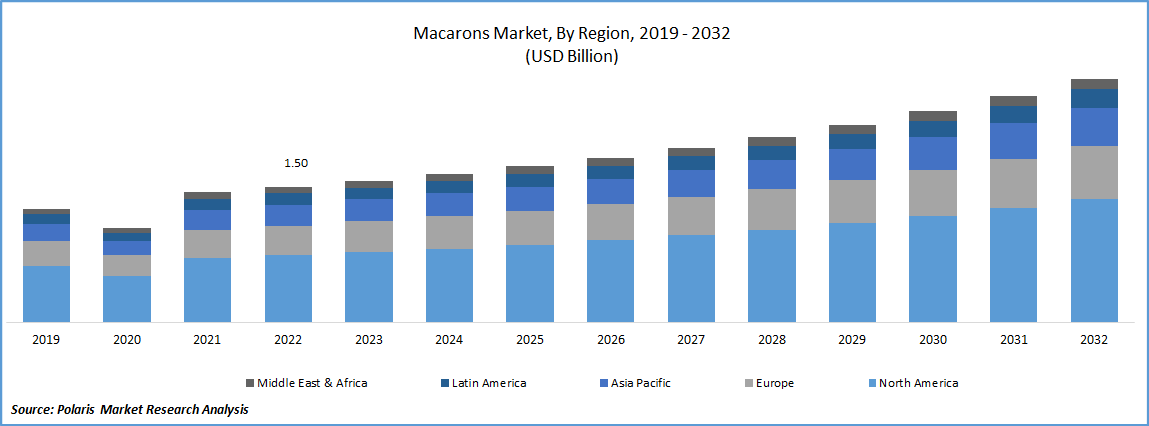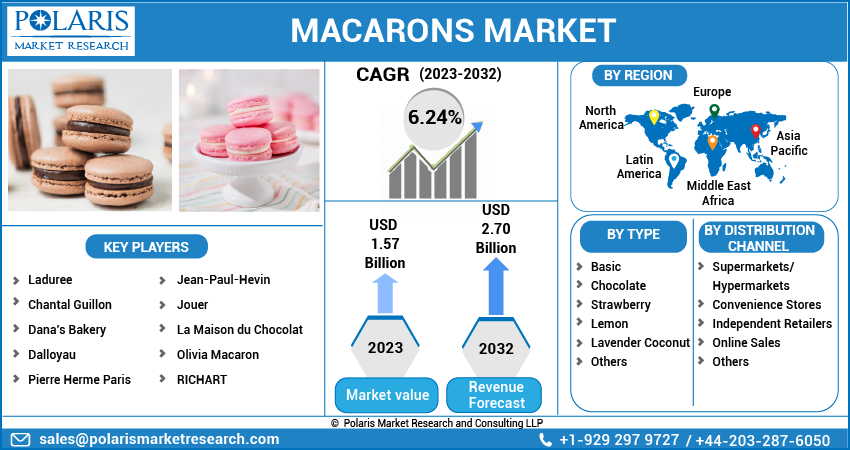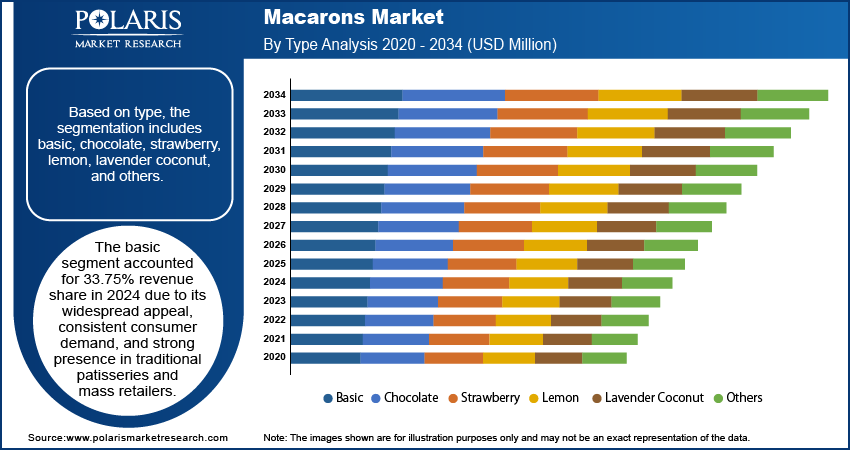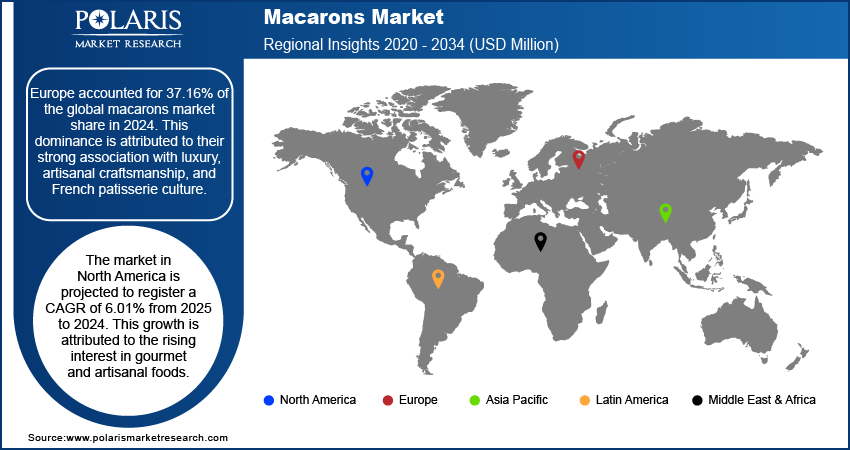
Macarons Market Size, Share, Trends, Industry Analysis Report
By Type (Basic, Chocolate, Strawberry, Lemon, Lavender Coconut, Others), By Distribution Channel, By Region – Market Forecast, 2025–2034
- Published Date:Aug-2025
- Pages: 129
- Format: PDF
- Report ID: PM3389
- Base Year: 2024
- Historical Data: 2020-2023
The global macarons market size was valued at USD 1,313.00 million in 2024, growing at a CAGR of 6.44% from 2025 to 2034. Key factors driving demand for macarons include rising disposable income globally, expanding urbanization, expansion of e-commerce, and innovation in flavor and customization.
Key Insights
- The basic macaron segment captured 33.75% of revenue share in 2024, driven by its broad consumer appeal, consistent demand, and accessibility across bakeries and mass retailers catering to everyday indulgence.
- The chocolate macaron segment is anticipated to reach USD 700.08 million by 2034, supported by growing preference for rich, premium flavors and the rising popularity of chocolate-based confections globally.
- Supermarkets and hypermarkets accounted for 39.89% of revenue share in 2024, driven by strong consumer footfall, brand visibility, and competitive pricing across both premium and value-for-money macaron offerings.
- Europe led the global macarons market with a 37.16% share in 2024, fueled by cultural heritage, artisanal positioning, and established consumer demand for luxury pastries across Western European countries.
- France represented 27.79% of the European macarons market in 2024, driven by deep-rooted cultural associations, frequent gifting traditions, and strong domestic consumption tied to celebrations and traditional patisserie habits.
Industry Dynamics
- Rising demand for macarons is driven by growing consumer preference for premium desserts, aesthetic appeal, and their association with gifting and special occasions.
- Market expansion is supported by increasing artisanal production, product innovation in flavors and packaging, and global exposure through cafes, patisseries, and online retail platforms.
- Challenges such as high production costs, short shelf life, and the need for temperature-controlled logistics may hinder scalability in mass markets.
- Advances in frozen dessert technology, efficient supply chains, and customization through digital marketing are enhancing macaron accessibility, shelf stability, and consumer engagement.
Market Statistics
- 2024 Market Size: USD 1,313.00 million
- 2034 Projected Market Size: USD 2,430.17 million
- CAGR (2025-2034): 6.44%
- Europe: Largest market in 2024
AI Impact on Macarons Market
- AI analyzes consumer behavior and sales trends to forecast demand, optimize inventory, and guide product development in the macarons market.
- Integration of AI in production enables real-time quality control and predictive maintenance, improving consistency, reducing waste, and enhancing operational efficiency.
- AI-powered tools support personalized marketing strategies by segmenting audiences, optimizing campaigns, and driving higher engagement through tailored flavor and packaging preferences.
- AI streamlines supply chain management, automates logistics forecasting, and ensures timely restocking, improving delivery performance and reducing inventory holding costs for macaron retailers.

To Understand More About this Research: Request a Free Sample Report
A macaron is a French confection that consists of two small, round, and smooth-surfaced cookies made with a mixture of egg whites, almond flour, granulated sugar, icing sugar, and food coloring. Macarons are known for their delicate texture, vibrant colors, and wide variety of flavors. Traditional flavors include raspberry, chocolate, pistachio, vanilla, and coffee. However, creative bakers have introduced options such as matcha, truffle, and even savory versions, including foie gras. The usage of macarons extends beyond simple enjoyment as a sweet treat. People often serve macarons at weddings and birthday events due to their elegant appearance and customizable flavors.
The rising disposable income globally is driving the market growth. The Bureau of Economic Analysis, in its report, stated that disposable personal income in the U.S. increased by 0.6% in April 2025 from last year. This increase in disposable income is driving people to seek luxury or premium food products, including French delicacies such as macarons. Higher disposable income is also encouraging consumers to explore gourmet experiences, resulting in a greater demand for artisanal and high-quality desserts such as macarons.
The demand for macarons is driven by the expanding urbanization. The urban population is expected to more than double by 2050, as stated in the World Bank report. Urban people usually live in fast-paced lifestyles, making convenient food products such as macarons a popular choice for quick snacks or desserts. Urban areas also attract a younger population that values trendy foods, driving up sales of colorful and elegant macarons. The higher density of bakeries and specialty shops in urban areas further makes macarons more accessible, encouraging frequent purchases. Therefore, the demand for macarons is rising with the expanding urbanization globally.
Drivers & Opportunities
Expansion of E-commerce
E-commerce platforms allow bakeries and confectionery brands to reach customers beyond their physical stores, including those in areas without specialty patisseries, thereby increasing sales of macarons. Convenient delivery options and subscription services offered by e-commerce platforms also encourage impulse purchases and repeat orders, as customers can easily buy macarons with just a few clicks. E-commerce platforms further enable artisanal bakeries to sell premium, handcrafted macarons to a global audience, increasing their customer base. Additionally, e-commerce removes geographical and logistical barriers, making it easier for consumers to discover, purchase, and enjoy macarons, thereby boosting sales.
Innovation in Flavor and Customization
Innovation in flavor and customization is propelling demand for macarons by keeping consumers excited and eager to try new, unique variations. Creative flavor combinations such as matcha lavender, salted caramel, and exotic fruit infusions are appealing to younger populations who seek novel taste experiences. Customization options, such as personalized colors, fillings, or monogrammed designs are further attracting buyers seeking tailored treats for weddings, corporate events, and gifts. Bakeries globally are driving repeat purchases of macarons by constantly reinventing flavors and offering tailored choices. Hence, the rising innovation in flavors coupled with customization is fueling the adoption of macarons.

Segmental Insights
Type Analysis
Based on type, the segmentation includes basic, chocolate, strawberry, lemon, lavender coconut, and others. The basic segment accounted for 33.75% revenue market share in 2024 due to its widespread appeal, consistent consumer demand, and strong presence in traditional patisseries and mass retailers. Consumers consistently favored basic options such as vanilla and pistachio for their familiarity, balanced sweetness, and suitability for various occasions, including weddings, corporate events, and casual gifting. The basic segment also benefited from its established production processes, lower ingredient costs, and higher shelf stability, making it the go-to choice for bakeries seeking to scale operations without compromising on quality.
The chocolate segment is projected to reach USD 700.08 million by 2034. This growth is attributed to rising global demand for soft desserts and the growing popularity of premium cocoa-based confections. Chocolate-flavored variants are gaining traction in traditional French-style bakeries and through online gourmet dessert platforms and boutique cafés expanding their product portfolios. The ability of chocolate to pair well with various fillings, such as ganache, coffee, and raspberry, further enhances its appeal. Additionally, product innovation such as dark chocolate is continuously attracting younger, adventurous consumers, fueling growth of the segment.
Distribution Channel Analysis
In terms of distribution channel, the segmentation includes supermarkets/hypermarkets, convenience stores, independent retailers, online sales, and others. The supermarkets/hypermarkets segment held a 39.89% revenue share in 2024, due to their extensive reach, strong brand partnerships, and ability to offer both premium and affordable varieties under one roof. These retail outlets provided consumers with easy access to a wide selection of flavors and packaging options, often stocked in refrigerated dessert aisles or gourmet sections. The established supply chains and promotional strategies of these outlets, such as in-store tastings and bundled offers, helped drive consistent foot traffic and impulse macaron purchases. Furthermore, consumers trust the quality standards maintained by supermarkets/hypermarkets, encouraging regular purchases during weekly grocery trips or special celebrations.
The online sales segment is projected to register a CAGR of 7.71% from 2025 to 2034, owing to rising e-commerce penetration, convenience-driven shopping behavior, and the expansion of direct-to-consumer bakery brands. Online platforms allow buyers to explore curated assortments, customize orders, and access limited-edition or seasonal offerings not typically available in physical stores. The increasing use of visually appealing packaging and social media marketing is further enhancing the online visibility of premium confections such as macarons, encouraging impulse buys and gift orders. Additionally, improvements in cold chain and same-day delivery services are addressing concerns around product freshness, making online purchases more reliable and appealing to urban customer base.

Regional Analysis
The Europe macarons market accounted for 37.16% global market share in 2024. This dominance is attributed to their strong association with luxury, artisanal craftsmanship, and French patisserie culture. Consumers in the region are increasingly drawn to premium, high-quality desserts, with macarons symbolizing sophistication and premium. The growth of café culture, particularly in urban areas, has further boosted demand, as macarons are often paired with specialty coffee and tea. Additionally, the influence of social media has made macarons a popular choice in Europe for their vibrant colors and photogenic appeal. Seasonal trends, such as holiday-themed macarons, also contributed to their popularity across the regional markets.
France Macarons Market Insight
France held 27.79% macarons market share in Europe in 2024, with French consumers viewing macarons as a staple in patisserie and gifting, particularly for special occasions such as weddings and holidays. The emphasis on traditional baking techniques and high-quality ingredients further sustained macarons appeal in France. The Ministry of Economy of France announced 2024 a record year for French tourism, due to the growth of international visits. The 2024 attendance and revenue figures show that over 100 million international visitors came to France. Rising tourism also propelled the demand for macarons in the country, as visitors seek authentic French macarons.
North America Macarons Market Analysis
The market in North America is projected to register a CAGR of 6.01% from 2025 to 2024. This growth is attributed to the rising interest in gourmet and artisanal foods. Consumers in the region are willing to pay a premium for unique, high-end desserts, and macarons fit this trend perfectly. The influence of food bloggers, Instagram, and baking shows is elevating the status of macarons in the region as a luxury treat, leading to high consumption. Additionally, the growing demand for gluten-free food and desserts is fueling the demand for macarons, as they are naturally gluten-free. Specialty bakeries and supermarkets in countries such as the U.S. and Canada are expanding accessibility, further driving demand.
U.S. Macarons Market Overview
The U.S. is estimated to hold 78.12% revenue share of the market in North America by 2034. Major cities such as New York and Los Angeles are witnessing a proliferation of macaron boutiques, catering to health-conscious and luxury-seeking consumers. The demand is also fueled by celebrity endorsements and their frequent appearance in lifestyle media. Furthermore, the rise of online dessert delivery services in the region is making macarons more accessible nationwide, leading to market growth.
Asia Pacific Macarons Market Assessment
The market in Asia Pacific is projected to hold a substantial share in 2034, due to the growing middle class and increasing Western influence on food trends. Various countries such as Japan, South Korea, and China are witnessing macarons as a symbol of affluence and modernity, making them popular as gifts and luxury treats. Social media platforms such as Weibo and Instagram are amplifying the appeal of macarons, with consumers drawn to their aesthetic presentation. Additionally, international pastry chains are expanding in the region, introducing macarons to new audiences, contributing to industry growth.

Key Players and Competitive Analysis
The macaron industry features a mix of boutique bakeries, artisanal brands, and established confectionery players competing for consumer attention. Leading brands such as Olivia Macaron, Le Macaron, and Decadent Macaron focus on premium ingredients and creative flavors, targeting luxury consumers and gift buyers. French-inspired brands such as Jean Trogneux and RICHART emphasize authenticity and traditional craftsmanship, appealing to purists seeking classic Parisian-style macarons. Meanwhile, Brioche Pasquier and Coco Bakery Inc. leverage mass production and retail distribution to offer affordable, widely accessible options. Specialty chocolatiers such as SMOOR Chocolates and PMSWEET diversify their offerings by incorporating macarons into gourmet gift sets, competing on both taste and presentation. Regional bakeries, such as Dana’s Bakery, differentiate themselves through unique flavors, customization, and strong local followings. The competitive landscape also includes online retailers and subscription services, which expand product reach by delivering fresh macarons directly to consumers.
A few major companies operating in the macarons industry include Brioche Pasquier, Coco Bakery Inc., Dana's Bakery, Decadent Macaron, Jean Trogneux, Le Macaron, Mama Mia, Olivia Macaron, PMSWEET, RICHART, and SMOOR Chocolates.
Key Players
- Brioche Pasquier
- Coco Bakery Inc.
- Dana's Bakery
- Decadent Macaron
- Jean Trogneux
- Le Macaron
- Mama Mia
- Olivia Macaron
- PMSWEET
- RICHART
- SMOOR Chocolates
Industry Developments
January 2023: Mama Mia announced the launch of first-ever Gelato Macarons in India.
April 2023: Le Macaron French Pastries announced the expansion with the openings of three new locations in Michigan, Maryland; and Florida.
Macarons Market Segmentation
By Type Outlook (Revenue, USD Million, 2020–2034)
- Basic
- Chocolate
- Strawberry
- Lemon
- Lavender Coconut
- Others
By Distribution Channel Outlook (Revenue, USD Million, 2020–2034)
- Supermarkets/Hypermarkets
- Convenience Stores
- Independent Retailers
- Online Sales
- Others
By Regional Outlook (Revenue, USD Million, 2020–2034)
- North America
- U.S.
- Canada
- Europe
- Germany
- France
- UK
- Italy
- Spain
- Netherlands
- Russia
- Rest of Europe
- Asia Pacific
- China
- Japan
- India
- Malaysia
- South Korea
- Indonesia
- Australia
- Vietnam
- Rest of Asia Pacific
- Middle East & Africa
- Saudi Arabia
- UAE
- Israel
- South Africa
- Rest of Middle East & Africa
- Latin America
- Mexico
- Brazil
- Argentina
- Rest of Latin America
Macarons Market Report Scope
|
Report Attributes |
Details |
|
Market Size in 2024 |
USD 1,313.00 Million |
|
Market Size in 2025 |
USD 1,385.46 Million |
|
Revenue Forecast by 2034 |
USD 2,430.17 Million |
|
CAGR |
6.44% from 2025 to 2034 |
|
Base Year |
2024 |
|
Historical Data |
2020–2023 |
|
Forecast Period |
2025–2034 |
|
Quantitative Units |
Revenue in USD Million and CAGR from 2025 to 2034 |
|
Report Coverage |
Revenue Forecast, Competitive Landscape, Growth Factors, and Industry Trends |
|
Segments Covered |
|
|
Regional Scope |
|
|
Competitive Landscape |
|
|
Report Format |
|
|
Customization |
Report customization as per your requirements with respect to countries, regions, and segmentation. |
FAQ's
The global market size was valued at USD 1,313.00 million in 2024 and is projected to grow to USD 2,430.17 million by 2034.
The global market is projected to register a CAGR of 6.44% during the forecast period.
Europe dominated the market share in 2024.
A few of the key players in the market are Brioche Pasquier, Coco Bakery Inc., Dana's Bakery, Decadent Macaron, Jean Trogneux, Le Macaron, Mama Mia, Olivia Macaron, PMSWEET, RICHART, and SMOOR Chocolates.
The basic segment dominated the market share in 2024.
The online sales segment is expected to witness the fastest growth during the forecast period.
